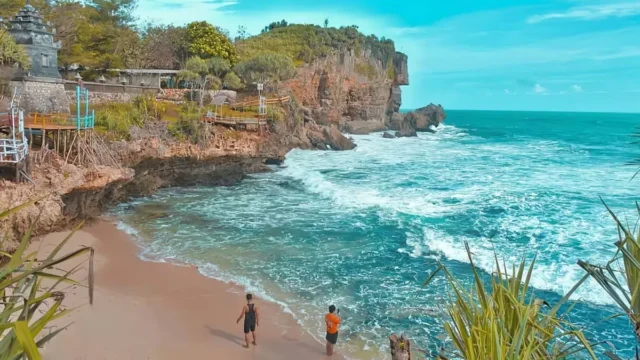Beyond its reputation as a cultural and historical hub, Yogyakarta quietly harbors one of Java’s best-kept secrets: a coastline brimming with natural beauty, geological marvels, and a rich tapestry of local legends. While many travelers flock to its temples and palaces, Yogyakarta’s southern shores unveil a different kind of magic untouched beaches that rival the world’s most iconic coastal destinations.
A Coastal Canvas of Contrasts
Stretching across the southern edge of Central Java, Yogyakarta’s coastline presents a dynamic interplay between nature’s rugged drama and tranquil elegance. This region offers everything from black volcanic sands and cavernous cliffs to calm lagoons and expansive beaches ideal for water sports and relaxation. Unlike Indonesia’s more commercialized beach destinations, Yogyakarta’s shores remain largely unspoiled, preserving their authenticity and charm.
What sets these beaches apart is not only their beauty but also their geological diversity. The area’s volcanic origin has sculpted a coastal terrain unlike any other in Southeast Asia. Massive rock formations emerge from turquoise waters, creating hidden alcoves and photogenic cliffs that are particularly striking during sunrise and sunset. The consistent monsoon climate—dry from April to October and lush during the rainy season gives each beach a distinct character throughout the year.
Hidden Havens and Local Lore
Each beach along Yogyakarta’s coast tells its own story:
- Ngobaran Beach exudes cultural mysticism, where Hindu and Javanese traditions coalesce beside scenic casuarina-lined shores. It’s not just a place to unwind it’s a cultural experience layered with spirituality and local flavor.
- Wediombo Beach is an adventurer’s retreat, its natural tidal lagoon providing a rare, calm swimming spot framed by the ocean’s untamed power. The local myth of a reclining stone figure adds an element of folklore to the breathtaking view.
- Siung Beach has earned its reputation as a surfer’s sanctuary, its powerful waves crashing beneath towering limestone cliffs. But beyond the surf, the low tide reveals hidden caves that add a new level of discovery.
- Sundak Beach is the ideal antidote to a hectic itinerary. Flanked by gentle waves and swaying palms, it’s perfect for family picnics or introspective strolls along the quiet coastline.
- Indrayanti Beach blends leisure and excitement. Popular for its water sports and vibrant beachside eateries, it transforms into a nightlife hotspot when the sun dips below the horizon.
- Parangtritis Beach is steeped in cultural lore, believed to be watched over by the mythical Queen of the South Sea. Beyond its aesthetic appeal, it offers spiritual and historical depth, with ancient temples and sand dunes ripe for exploration.
- Sepanjang Beach lives up to its name—meaning “long beach” with uninterrupted stretches of sand and a laid-back atmosphere, ideal for seafood feasts and leisurely motorbike rides.
- Glagah Beach offers something different with its volcanic black sand and calm lagoons. It’s a favorite for horseback riding and early morning photography sessions.
- Pok Tunggal Beach, often referred to as “Virgin Beach,” is accessible only by boat, preserving its untouched beauty. It’s a must-visit for travelers seeking solitude and pristine waters.
- Timang Beach offers adrenaline-pumping thrills with its iconic wooden gondola bridge suspended over crashing waves. It’s not for the faint-hearted but rewards the brave with unmatched views and a taste of traditional engineering.
Beyond the Shoreline
Yogyakarta’s beaches are more than sandy retreats—they’re ecological havens. Rich coral reefs, mangrove forests, and marine life like sea turtles and dolphins create immersive nature experiences. These areas serve as living laboratories for eco-tourism and sustainable travel, especially with increasing efforts from local communities to preserve their natural heritage.
One standout initiative is Moana Cycling Tour, a local venture redefining the way tourists explore the region. Through guided bike tours along coastal roads and through rural villages, travelers gain a deeper appreciation of the land, people, and history that shape Yogyakarta. It’s an active, low-impact way to engage with the destination whether riding past emerald rice fields or pausing to witness traditional fishing techniques in action.
When to Visit
The best window to experience Yogyakarta’s beaches is during the dry season, particularly from April to October. While July and August tend to attract more visitors, those looking for tranquility may prefer shoulder months like May or September. These months provide ideal weather conditions without the crowds, allowing travelers to explore freely and soak in the unfiltered charm of Java’s southern coast.
Final Thoughts
In a country known for its island paradises, Yogyakarta’s beaches remain refreshingly under the radar. They are not just stopovers—they’re destinations in their own right, each offering a unique blend of beauty, mystery, and adventure. Whether you’re paddling through a crystal-clear lagoon, crossing a cliffside bridge, or simply enjoying grilled fish on a sun-drenched terrace, Yogyakarta’s coast has a way of surprising and staying with you.
For travelers yearning for more than a postcard-perfect view, these shores deliver a journey into Java’s soul. And in that journey, you’ll find not just a beach, but a story worth telling.
For additional travel tips and to discover more of Indonesia’s hidden treasures, be sure to visit our website at Inca Travel .







